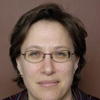Associate Professor and Director of the Program in Media Studies, Catholic University in Washington, DC.

Research Sample: Abstract of Always Already New: Media, History and the Data of Culture (Cambridge, MA: MIT Press, 2006)
The curiously perennial newness of today’s “new media” suggests that media are uniquely complicated subjects of history. Inscriptive media in particular are so bound up in the operations of history that historicizing them can be a challenge, since there is no getting all of the way “outside” to perform the work of historical analysis unencumbered by the discursive conditions of which they have become part. A modern sense of history — of facticity in relation to the past — is inextricable from experiences of inscription, of writing, print, photography, sound recording, cinema, and now — one must wonder — digital media that save text, image, and sound files. Specifically when media are new, they help to challenge deeply held assumptions about the ways that meaning is authored and conveyed, revealing the points at which those assumptions remain importantly unsettled. Part One begins with an account of the earliest sound recordings and their demonstration around the United States in 1878. When recorded sound was new, it was in some ways experienced as party to the existing, dynamic logics of writing, of print media, and of public speech. The new medium came to make sense only when its demonstration to and subsequent use by early audiences helped to construct a coincident yet partly contravening logic for recording, a logic which soon became self-evident and thus came to seem intrinsic to phonographs and phonograph records. Yet the implications of that emergent logic extended far beyond the eventual formal conventions of the medium, as recorded sound helped to broach questions about speech itself, the means and meaning of its selective preservation, which in turn helped to broach questions about the scope and character of American public life and public memory. Part Two uses a 1968 U.S. Supreme Court decision about draft card burning as free speech to introduce the cultural logic of material texts at the moment when distributed digital networks were first conceived and then initiated by the Advanced Research Projects Agency (ARPA) at the Pentagon. Distributed digital networks and the texts they make possible have emerged amid an existing textual economy, a world and workplace powerfully self-constituted according to the logic of contemporary media: print publication, broadcasting, Hollywood, and the record labels, but also punch cards, printouts, and paperwork. Experiences with digital networks have helped to construct a coincident yet contravening logic for electronic documents, partly in response to material features of the new medium and partly in response to the hugely varied contexts of their ongoing reception and development. In particular, the potential standing that electronic texts have as historical evidence is an outcome, not a precondition, of the logic that digital media are coming to possess specifically in relation to writing, print, and other media.
As a work of media history this book depends at a basic level upon the historical record, upon the documents that survive and to which its author has had access. As a work about doing media history this book insists that those very terms of inquiry — record and document — deserve self-conscious attention. It argues that there is a homology to be explored between the definition of records (phonographic and not) at the end of the nineteenth century, and the definition of documents (digital and not) at the end of the twentieth. Together records and documents stand as partial embodiments of the disciplinary groundwork/grounding of the humanities over the last century. Only by seeking broad genealogies for the social meanings of media and the corresponding materiality of texts, can scholars, students, and the additional users of media begin adequately to understand the ways that media accumulate the extraordinary power that they do.
